1lumen selects and reviews products personally. We may earn affiliate commissions through our links, which help support our testing.
Nightwatch NG01 review
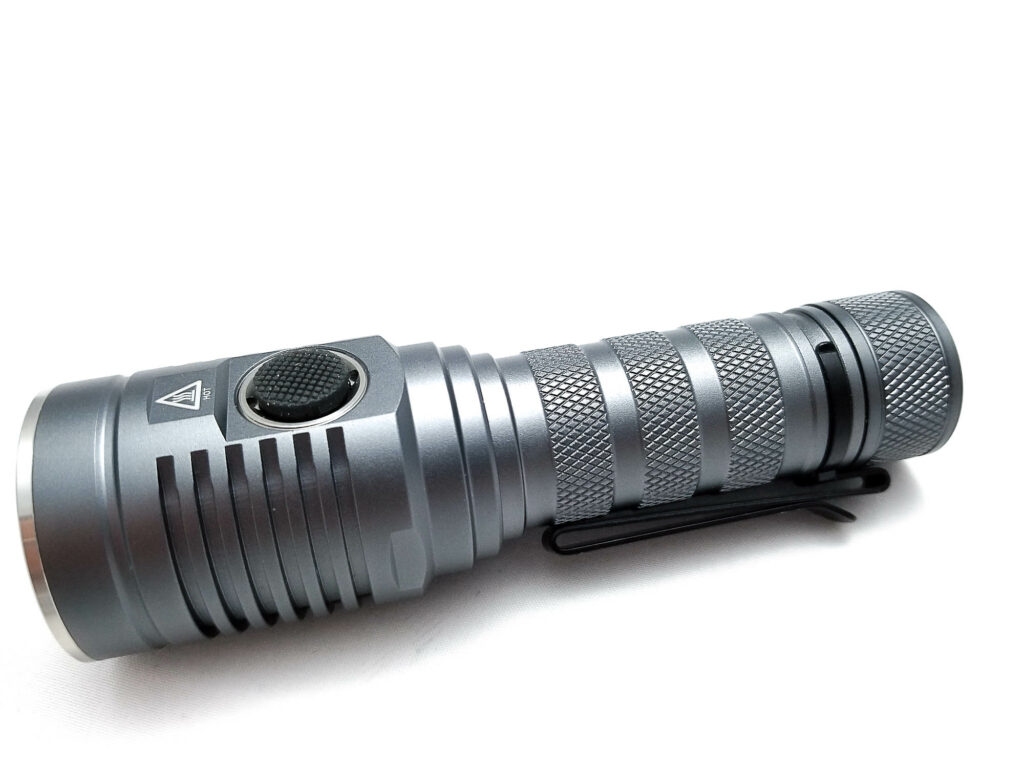
Nightwatch NG01 Legend specifications
| Brand & Model | Nightwatch NG01 Legend |
|---|---|
| Flashlight category | High output EDC flashlight |
| LED | 1*SFN60.2 |
| Max. output | 7500 Lumens |
| Max. beam distance | 410 meters |
| Max. beam intensity | ? |
| Battery config. | 1*21700 |
| Onboard charging | USB-C |
| Modes | 6 |
| Blinkies | Strobe |
| Waterproof | IPX6 |
| Review publication date | September 2022 |
Introduction:
Nestled in the box with the HT90 was this little gem from Nealsgadgets, the Nightwatch NG01, aka Legend. You might remember Nightwatch as the minds behind the (Chaotic) NS59v1 (and v2), NSX4, and the world’s brightest (?) EDC NS73V2 Incredible. While the NG01 isn’t on the same plane as those lights, it represents a step in the right direction for Nightwatch because this is a pocketable, single 21700, USB C rechargeable EDC…with 7500 advertised Lumens. Yep, that’s brighter than the MF01 Mini, the Emisar D4Sv2, Fireflies E07X, BLF Q8, and Sofirn SP36 BLF. It gets that firepower from the mysterious SFH60.2 LED and (of course) a FET driver. Moreover, this is the first Nightwatch small enough to be feasibly pocket carried (and includes a pocket clip). Let’s see if the Legend really is…legendary. It has to be since it’s coming into a very, very crowded room full of awesome, proven competitors.
Package quality.
I don’t expect nice packaging from budget Chinese flashlight manufacturers. Most of the time I get a box, (or not) with a flashlight and some bits inside. That’s it, and I’m fine with that. This time, that’s what I got. A knackered plain box. With a light inside wrapped in bubble wrap.
- Nightwatch NG01 flashlight
That’s all folks. Just a light. Moving on…okay the production light will probably include a lanyard and an o-ring (or not), and a battery is an optional add-on.
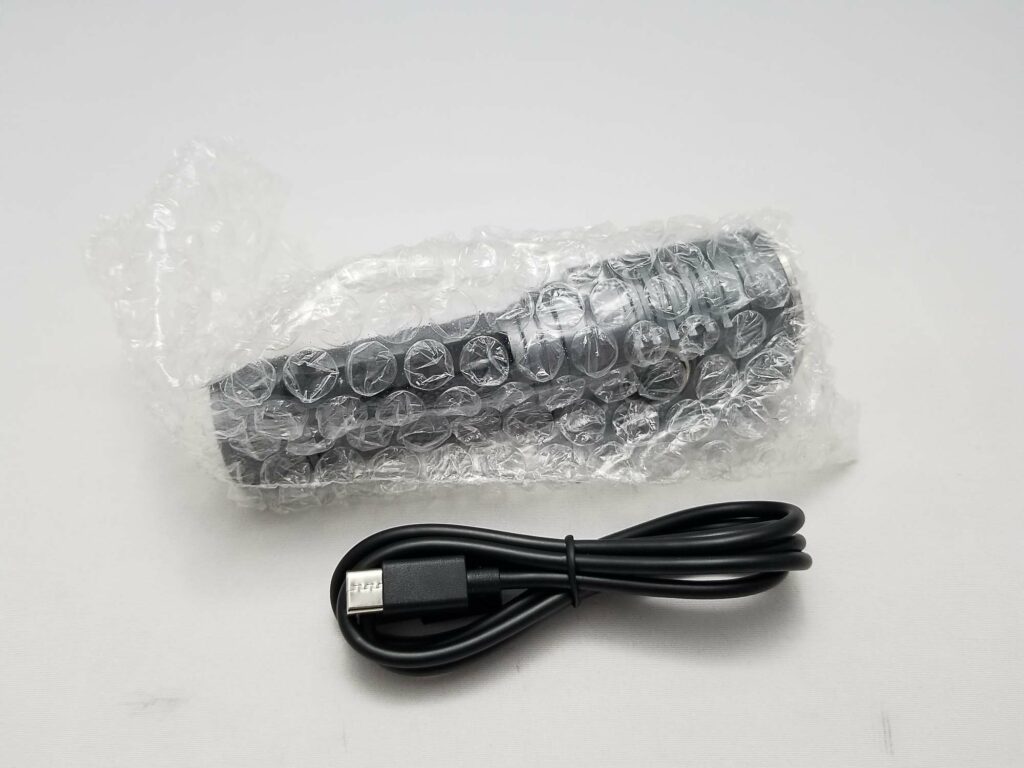
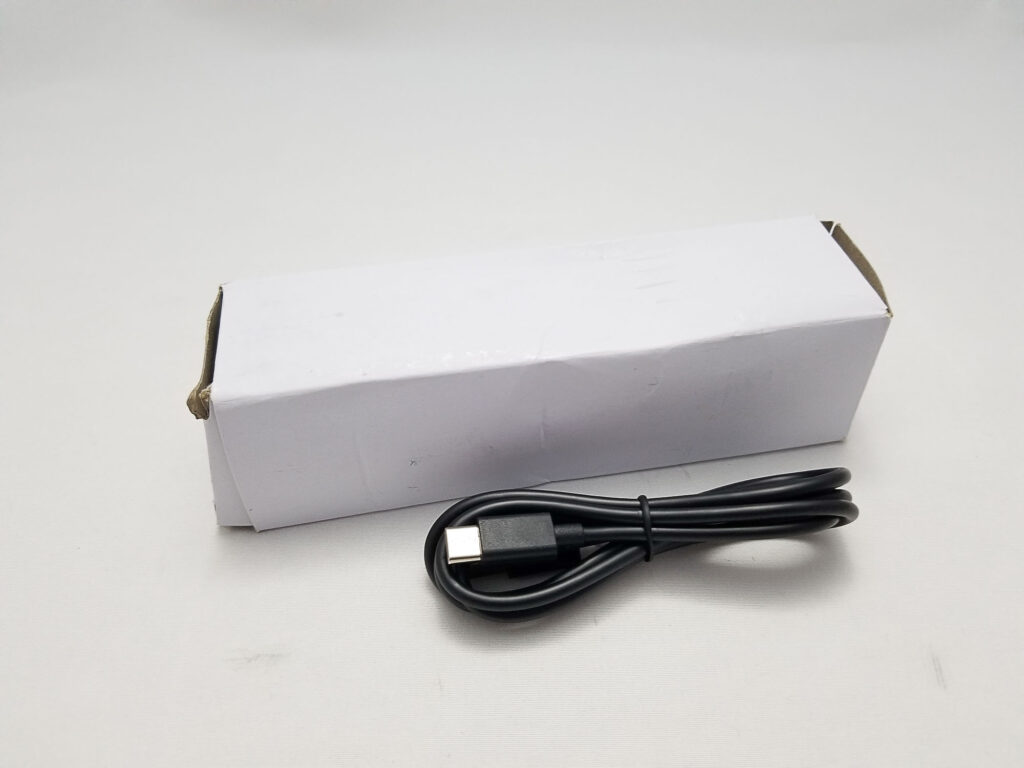
Flashlight in use
The NG01 is entering a segment of the market dominated by lights from Lumintop, Emisar/Noctigon, ReyLight, Rovyvon, and Sofirn. This is an EDC light, meant for general purpose pocket carry, so it would be best riding around in your pocket all day. These lights should be small, lightweight, have a balanced flood/throw beam, and produce around 2000 or so Lumens on high/turbo mode. The NG01 covers most of those.
This is a 21700 light, so it feels good in the hand and handles nicely. It’s a bit less maneuverable than a S2+ or FW3A though, and I rate the overall handling on par with the Fireflies E07 and WildTrail WT3M triple, which is one of my favorite high output EDC lights (just wish it had a clip).
Speaking of pocket clips, the NG01 has a dual position clip for bezel up or down carry. It rides pretty low in the pocket, but isn’t a deep carry clip. Pocket carry is okay. While I prefer 18650 or 14500 size hosts, if I were inclined to EDC a 21700 host, it would probably be a Thrunite T2, or WildTrail WT3M. That said, the NG01 isn’t terrible, and totally doable as an EDC.
Switching duties are handled by a side e-switch. It’s mounted in a shiny metal bezel/retaining ring, and the boot has very grippy texturing and sits proudly. It has very positive click action and requires decent effort to actuate so accidental activation won’t be an issue.
It has aux LEDs behind the boot for charge status, but they are not backlit during operation or standby. Opposite the e-switch is the USB charge port. It’s covered by a silicone rubber cover, and it makes a tight seal that requires some effort to fully seat, but the cover is a bit thin, and the tab for opening it had a tendency to snag on things and pull open, which is bad for keeping water and crud out of the internals.
Tail standing is a-okay, and the pocket clip keeps it from rolling away. Sadly, there’s nowhere to affix a lanyard, which is a big letdown. Although this may not be a big deal for some, it’s better to have it and not need it, than need it and not have it. Just saying.
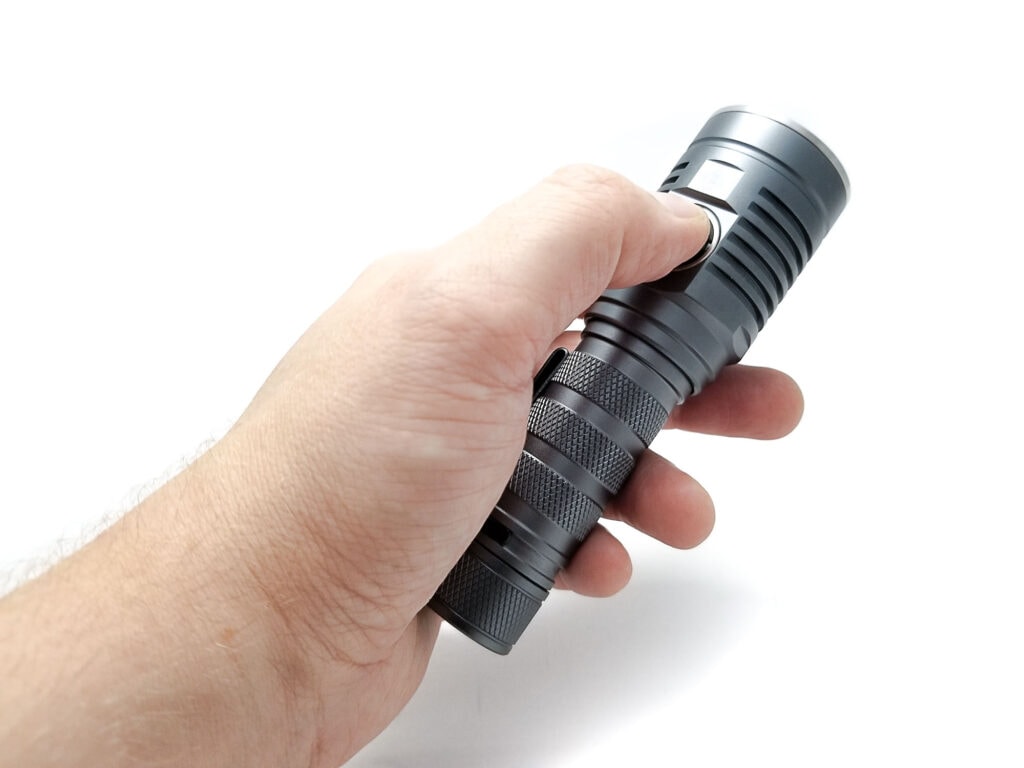
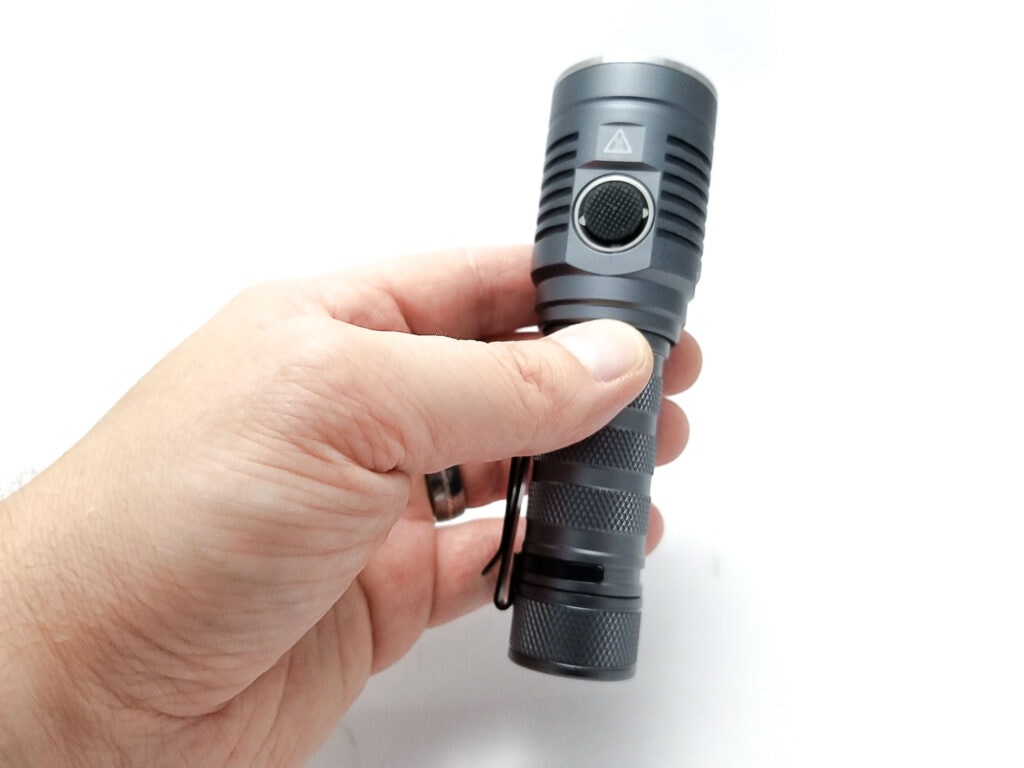
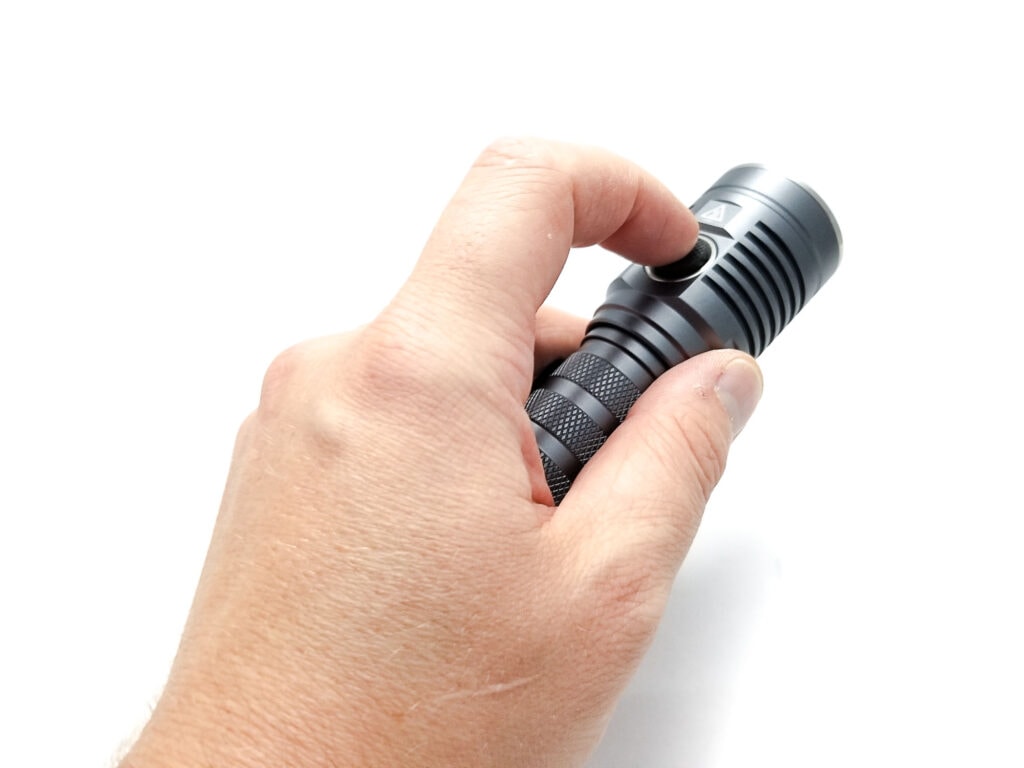
Build Quality, and Warranty
Nightwatch makes a no-frills, no fu-fu flashlight. It’s utilitarian, rugged, and simple to operate. Basically nothing fancy, and you won’t pay a fancy price for it either. With the SFH60.2 LED, the NG01 runs about $50 without a battery. Not a bad price, but not cheap either. The build quality is perfectly adequate and nothing fancy. The light is milled from aluminum of some kind, and the machining is very good. The only machine marks I could find were under the charge port cover, but hey, outta sight, outta mind, right? There’s no sharp or abrupt edges anywhere, and all the pieces line up fine.
The finish is advertised as type III HA, and it’s a semi gloss finish and is very well done. No thin areas or blemishes to be found. I like the gray color, and it’s nice and even.
The NG01, like my other Nightwatch lights, can easily be disassembled. The aluminum bezel unscrews by hand, and the driver is held in with a retaining ring (no glue). The LED wires look to be 18 gauge, and they’re very short, so if you did want to extract the diver or MCPCB, you need to unsolder those first.
The MCPCB is a DTP copper unit, and all the solder joints look tidy. There’s a properly thick aluminum (?) slug for the driver’s positive contact, and the lone tail press-fit spring looks to be a high current BeCu unit. It needs to be! The finish on the driver contact is pretty rough, and I recommend hitting it with a file to smooth it out for a better contact path. There’s o-rings sealing every joint: Front and rear of the tube, bezel, and lens. The charge port cover (when you fully seat it, and provided it stays seated) creates a decent seal, and I expect it to be at least IPX6 or better.
Warranty? That’s anyone’s guess since there’s no documentation. It goes without saying that with these lights you’re at the mercy of whomever you bought it from. If you get it from Neal, expect the commensurate DOA guarantee and at least a 1 year warranty. Neal’s pretty good about taking care of defective lights or warranty issues.
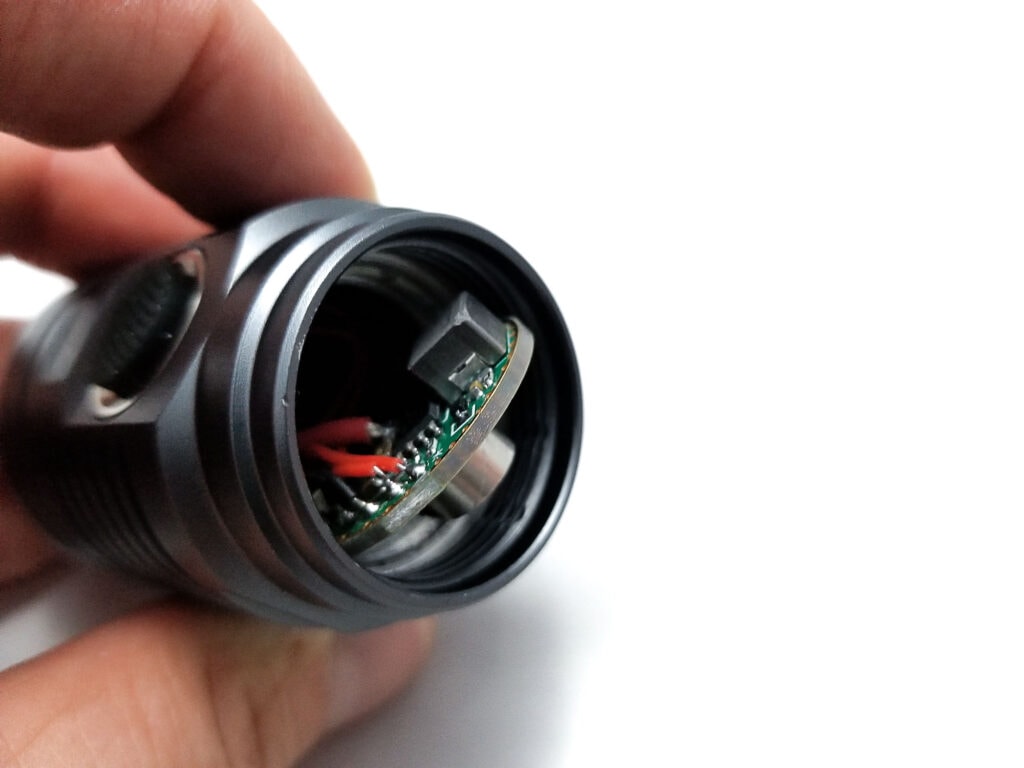
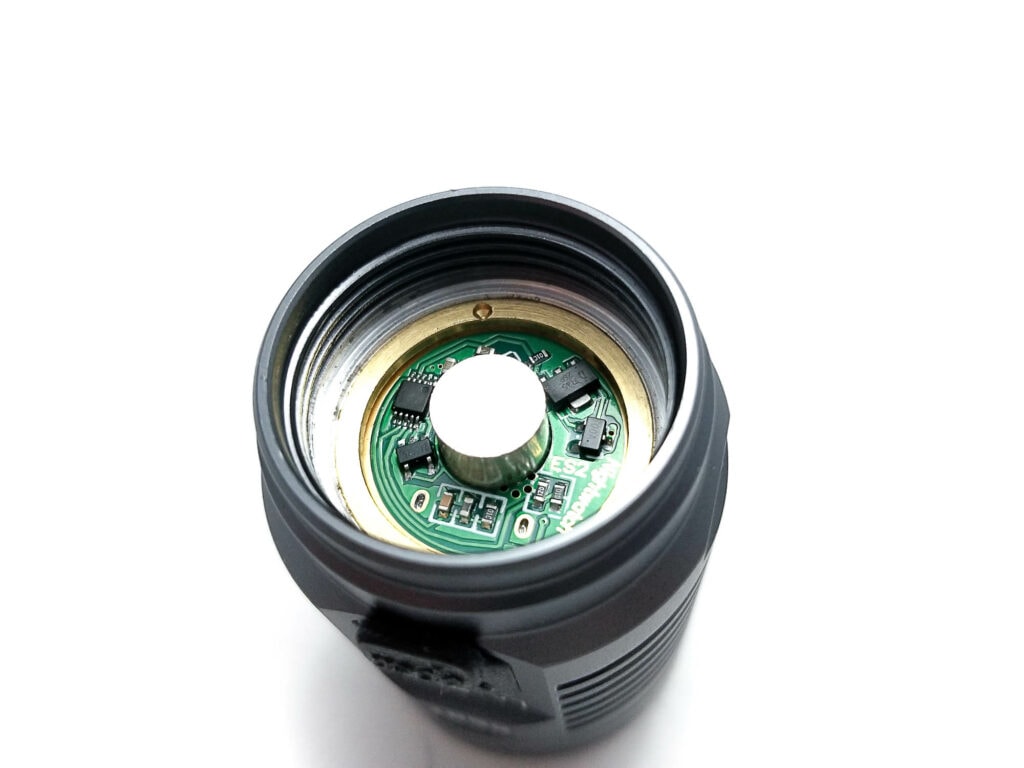
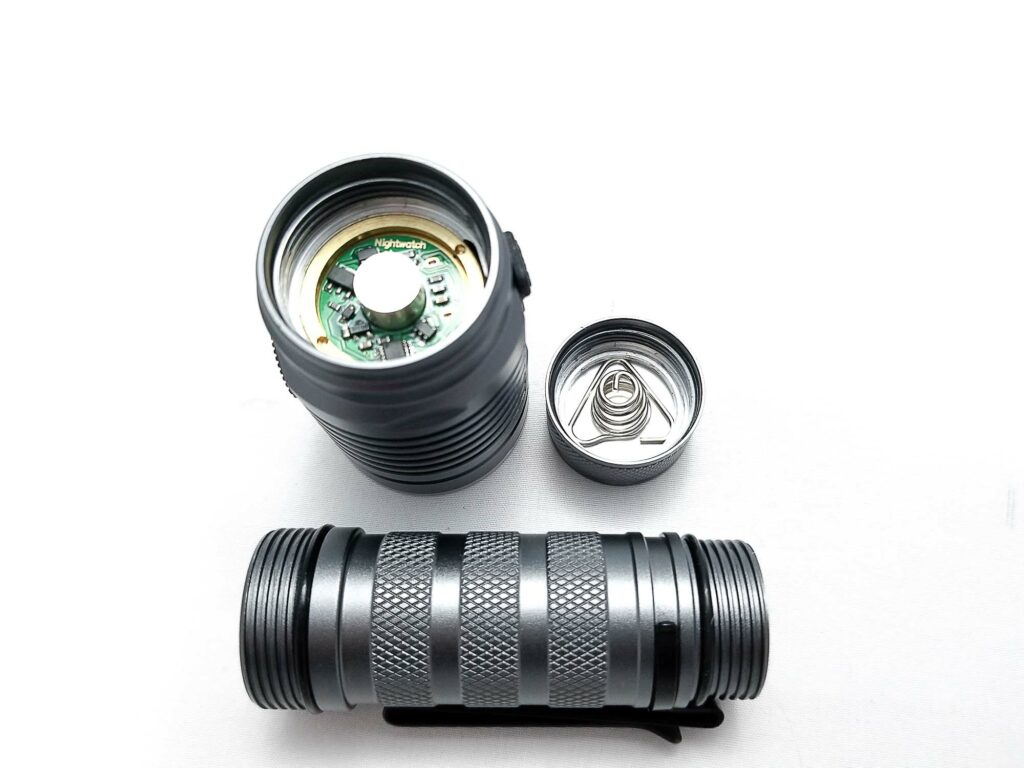
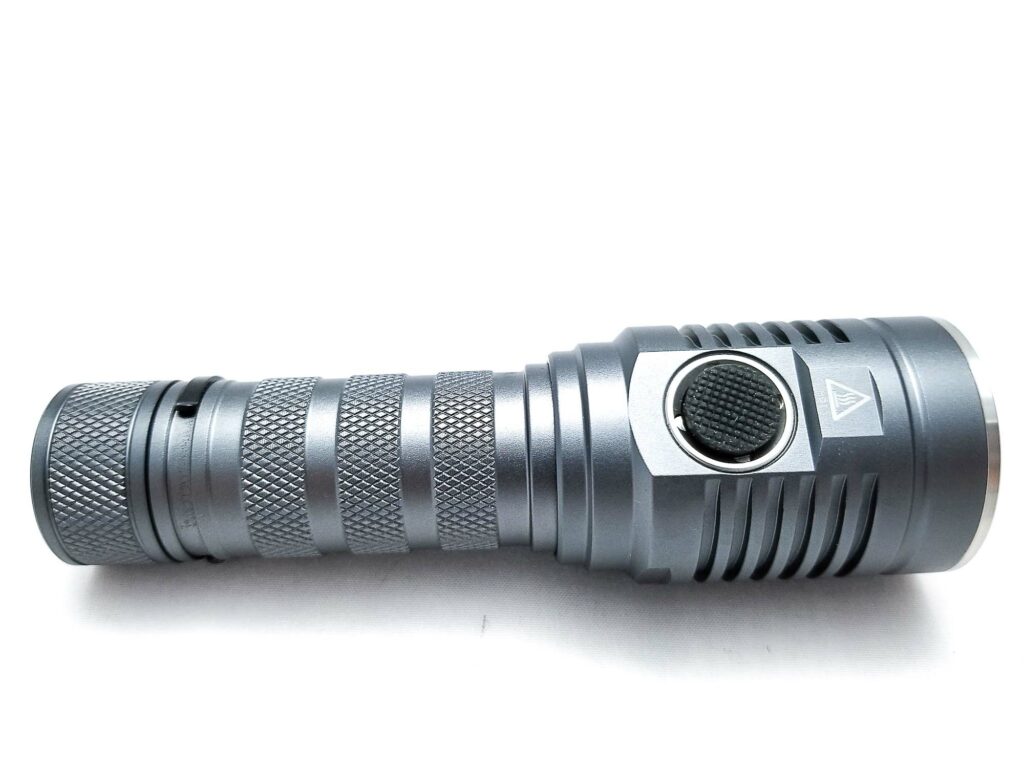
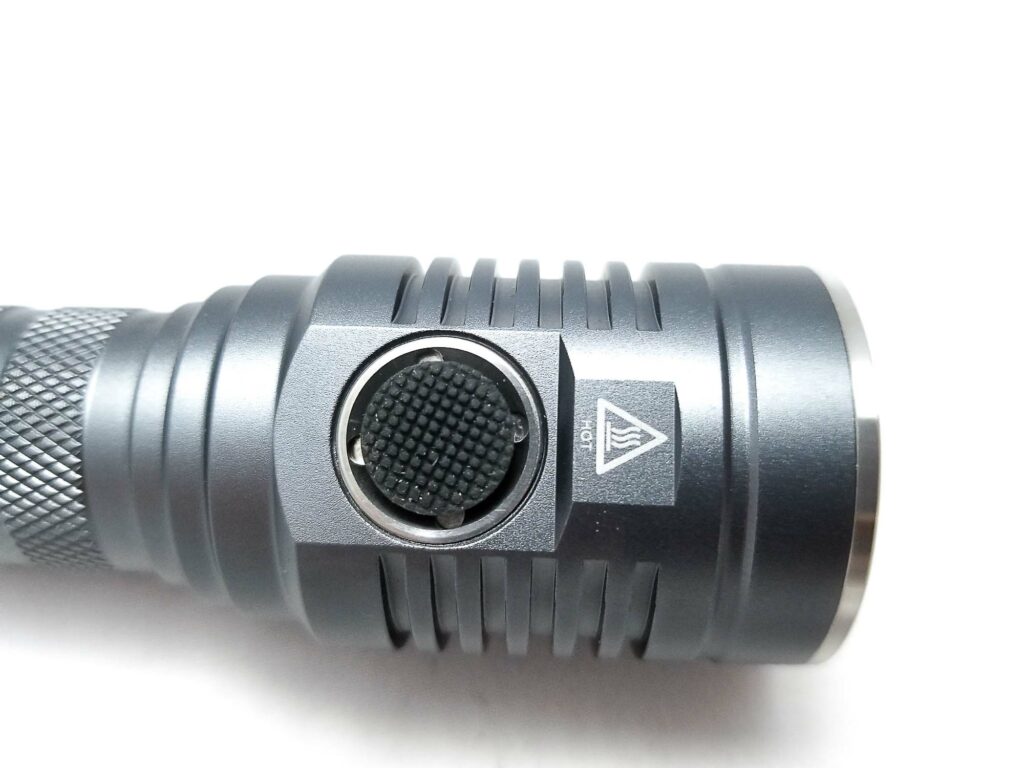
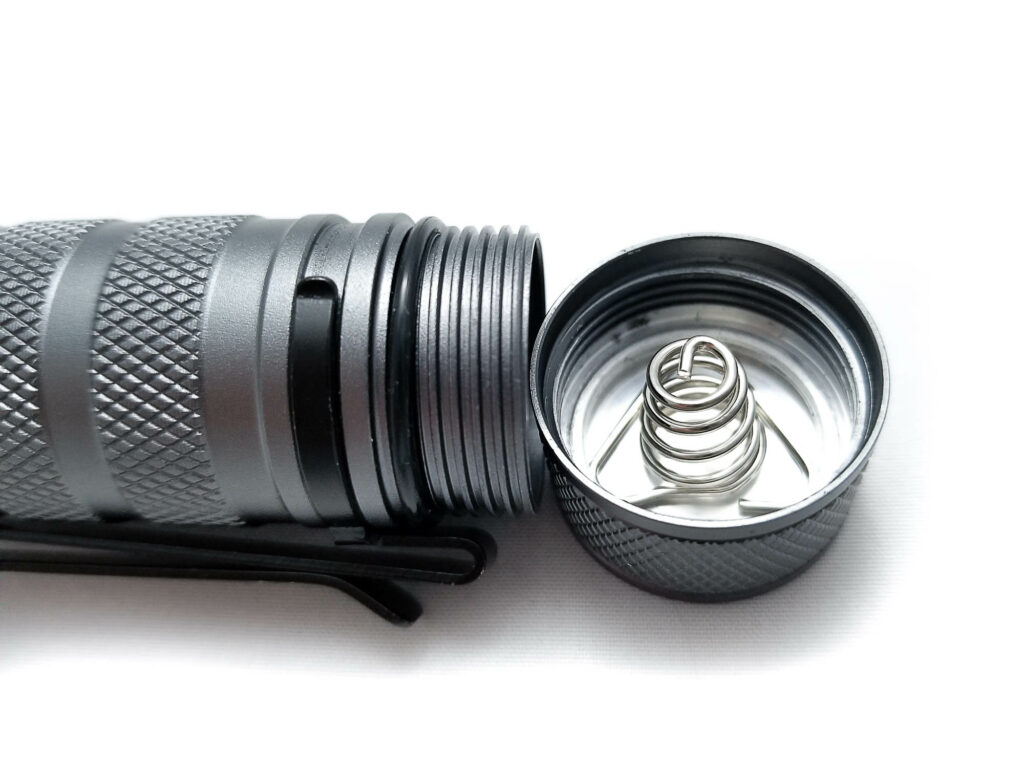
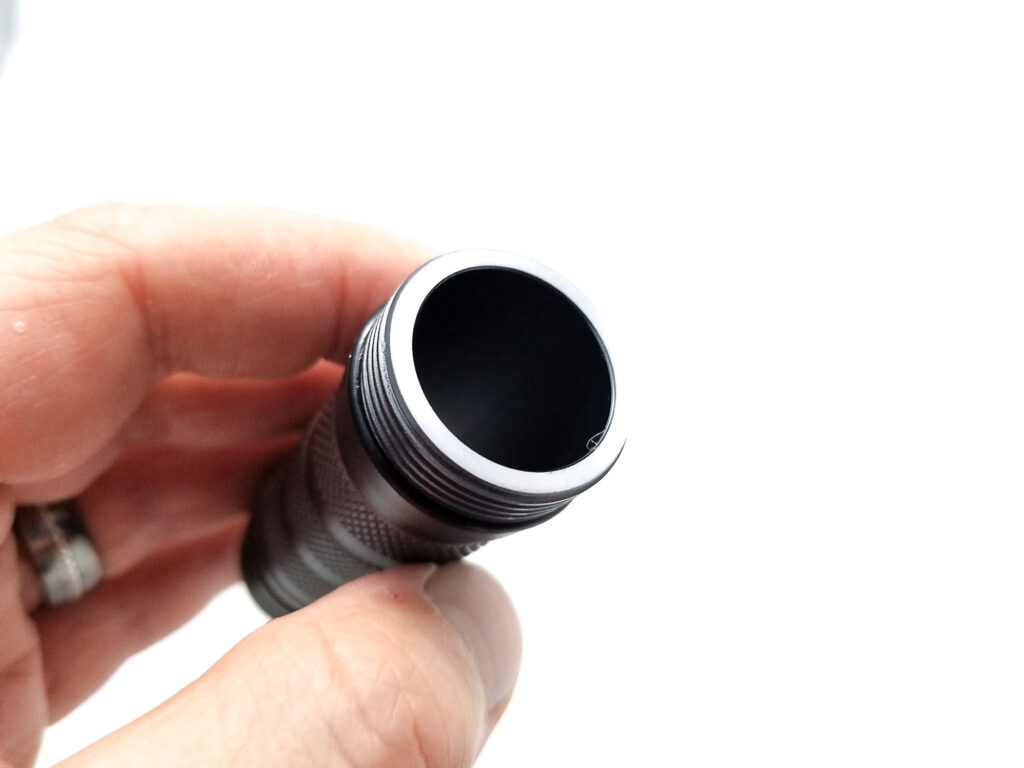
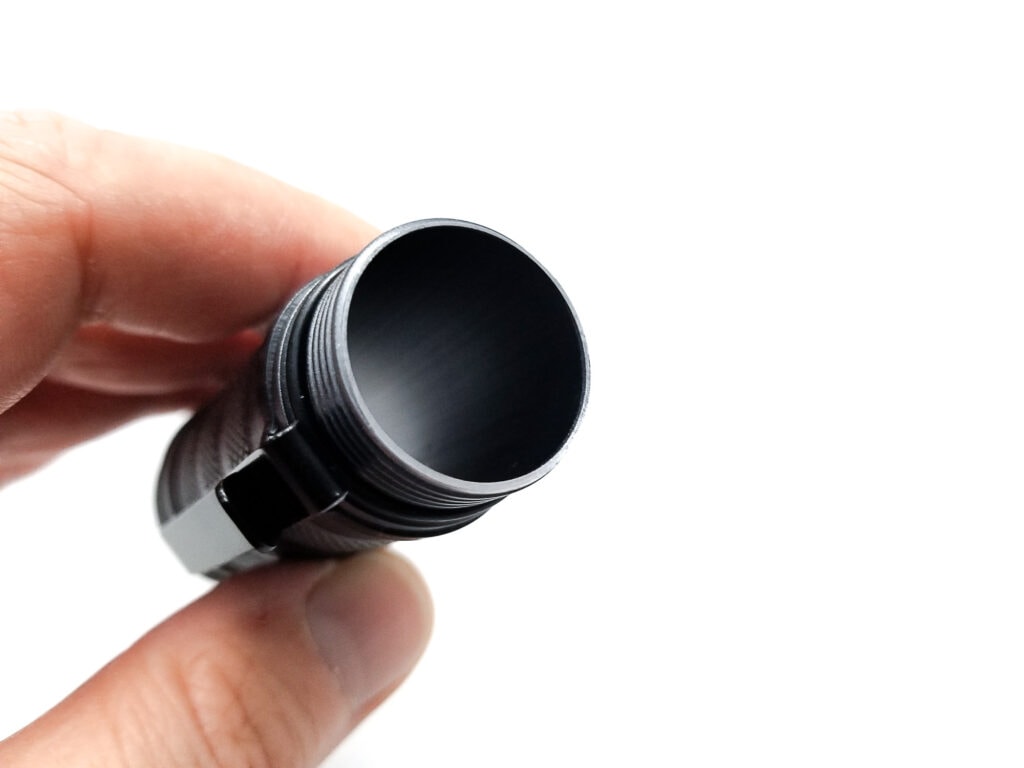
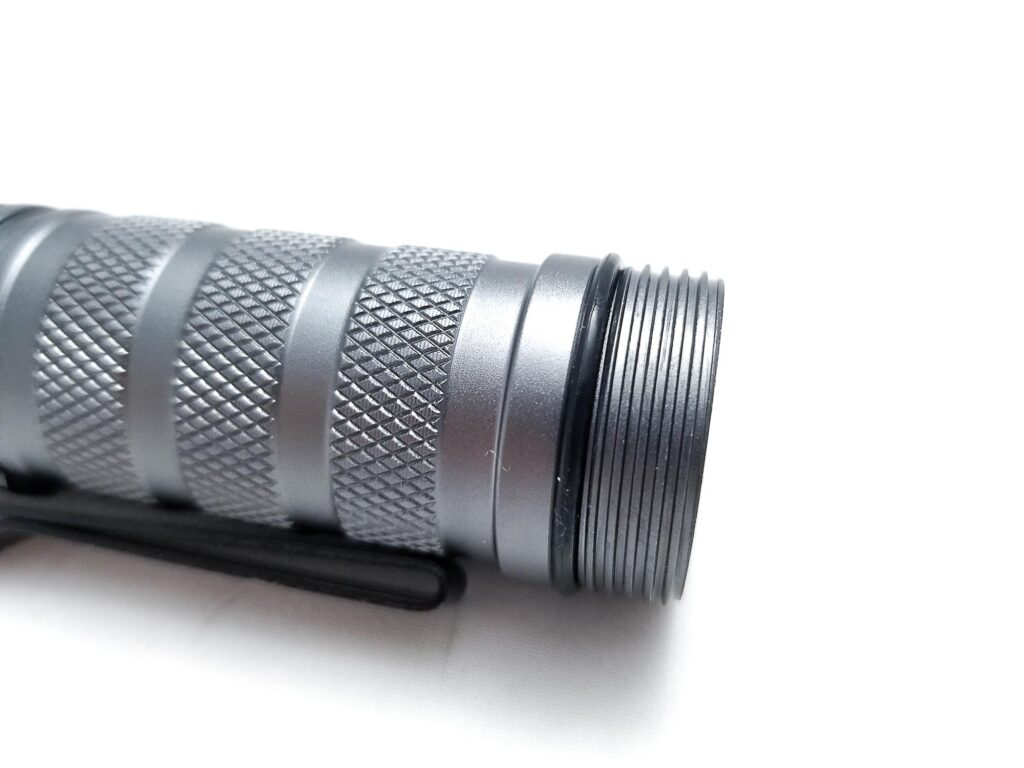
LED, Lens, Bezel, Beam, and Reflector
The NG01 is available with 2 LEDs. The sample light came with the hugely powerful SFN60.2, but it’s also available with the Luminus SFT-40-W high-intensity LED for a lot less output and a lot more throw. Keen-eyed readers might recognize the SFN60.2 as the same one in the Nightwatch NI03, NS73V2, and Lumintop D3. Although it’s known as the SFN55.2 in those lights, it’s practically the same LED. It’s a 7070 (7mm x 7mm, XHP70 footprint) size LED made up of 9, tiny dies that runs on 3 volts. It’s domeless and features a layout similar to a COB (chip on board) LED so the LES is not homogenous. However, you are guaranteed high output with huge amounts of current being consumed and a nicer, more even beam than an XHP70.2 or COB LED (and better throw). No tint is specified, but these Chinese LEDs are mostly cool white, and this one looks very cool.
The Opple Lightmaster Pro agrees. With the light on Turbo positioned 1 meter from the sensor, the tint comes in at 7550K with CRI (Ra) 72. Duv is -0.0035, so less green (which is nice). The lens is a dual AR-coated toughened glass, and underneath you’ll find a shallow OP reflector with the SFN60.2 sitting at the bottom. There’s no centering ring.
The beam has a lot of flood transitioning to a large, diffused hotspot. It has pretty decent reach, and only a little bit of corona and angular tint shift. Still, nowhere near as bad as a full-on XHP70.2.
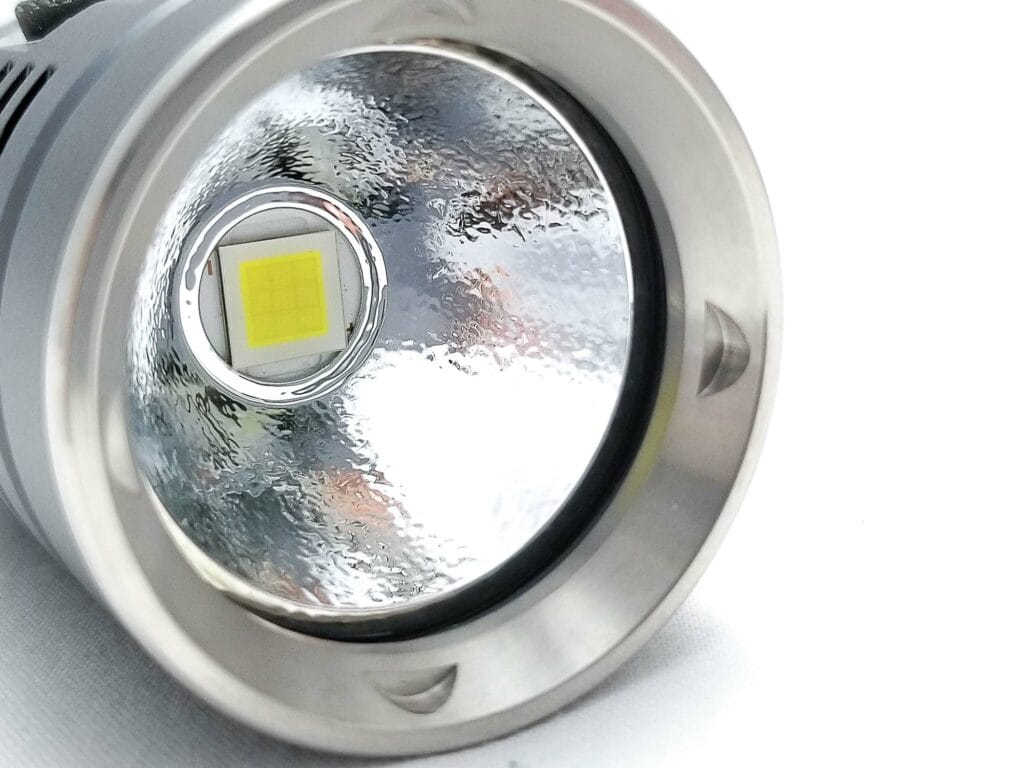
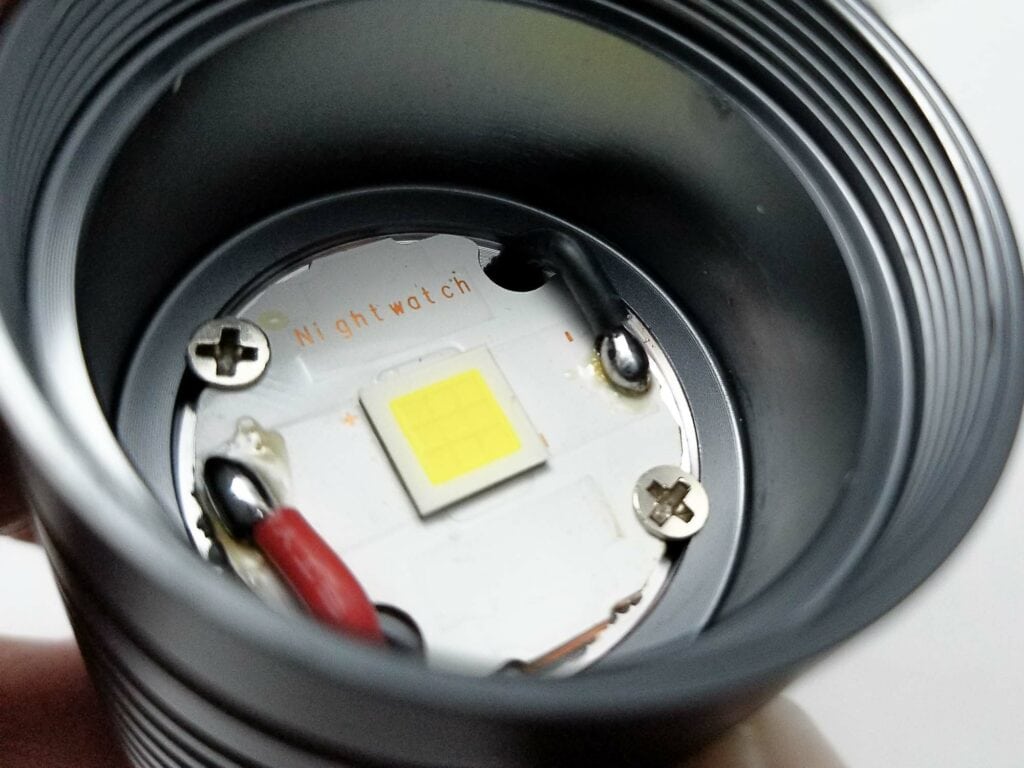
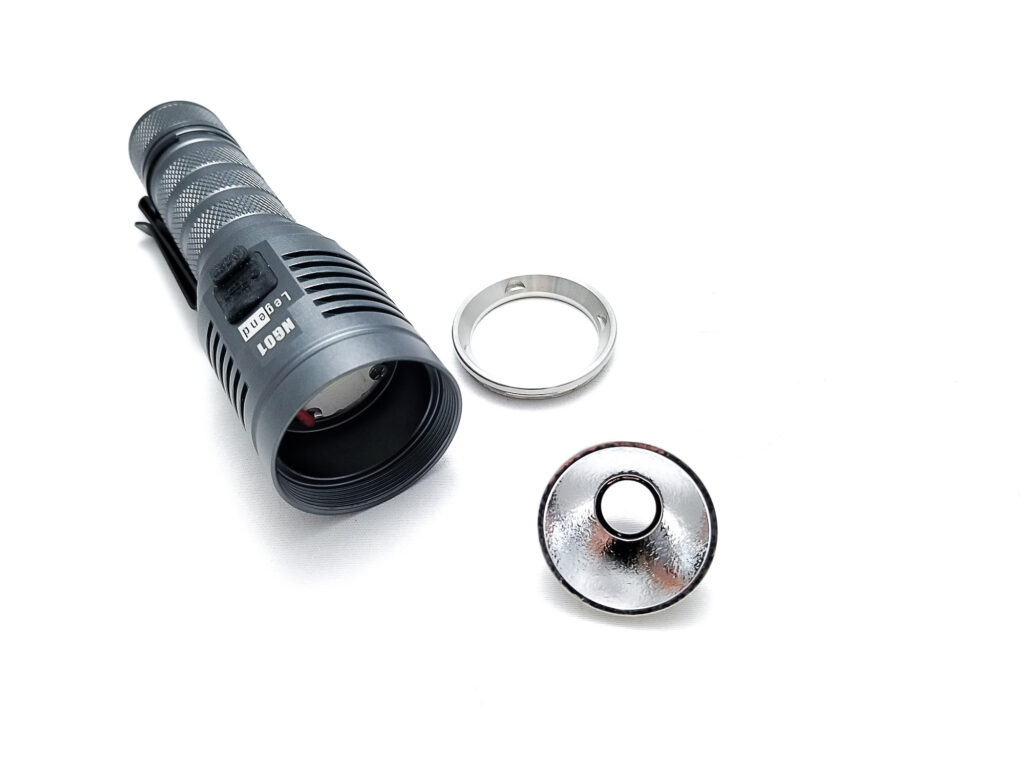
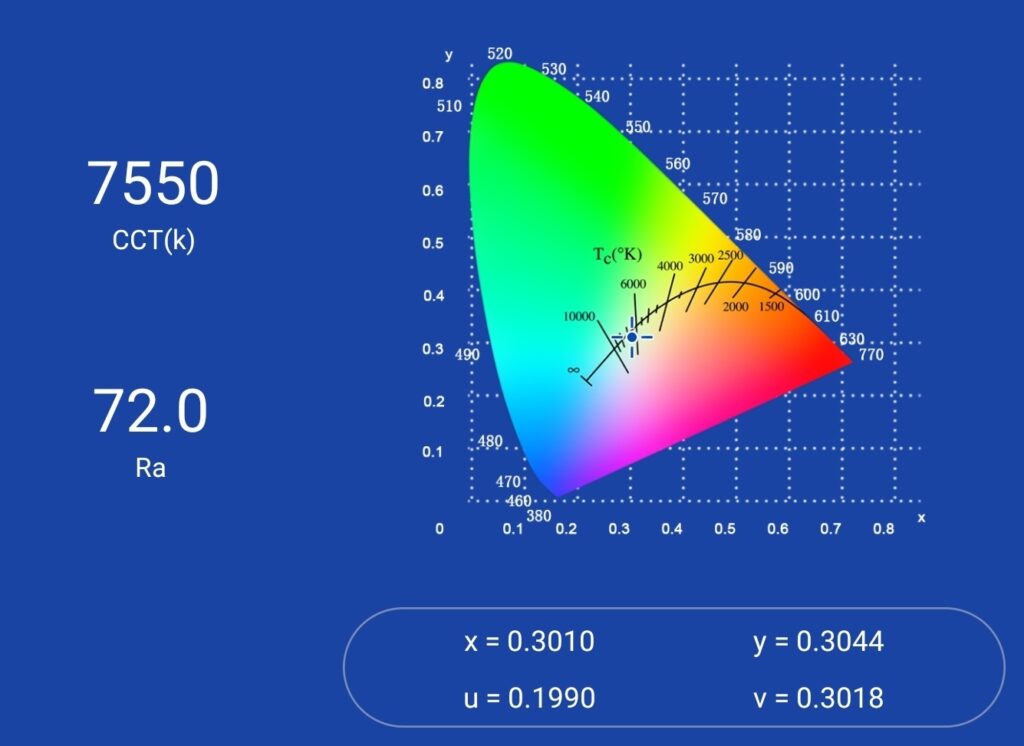
Dimensions and size comparison
Dimensions:
| Dimension | Millimeters | Inches |
|---|---|---|
| Length | 127 | 5 |
| Head diameter | 38 | 1.49 |
| Body diameter | 38 | 1.49 |
Weight:
| Weight | Grams | Oz. |
|---|---|---|
| Without battery | 151 | 5.3 |
| With Molicel P42A 21700 | 217 | 7.6 |
Flashlight size comparison with its competition
I compared NG01 to some EDC lights and high output pocketable lights.
Group 1 left to right: Nightwatch NI03 Valkyrie, Nightwatch NG01, Lumintop D3, Amutoch XT45 NB90.16
Group 2 top to bottom: Thorfire C8, Nightwatch NG01, Thrunite T2, Fireflies E07 2021
Group 3: left to right: Emisar D1 2022, Nightwatch NG01, WildTrail WT3M, Lumintop FWAA
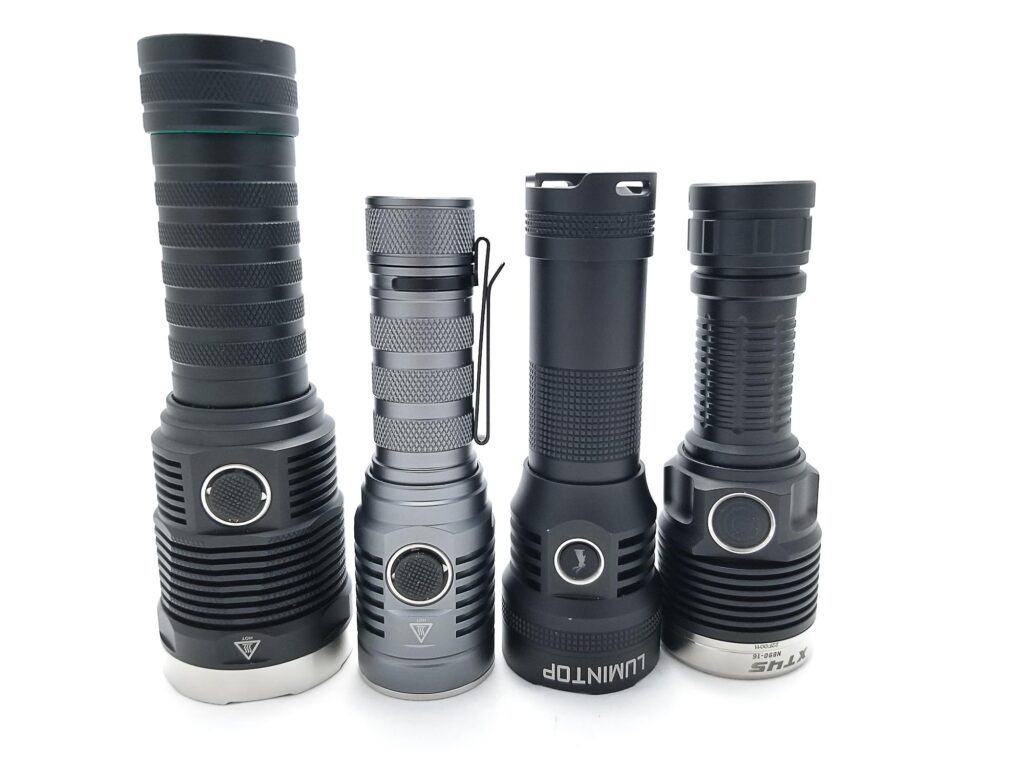
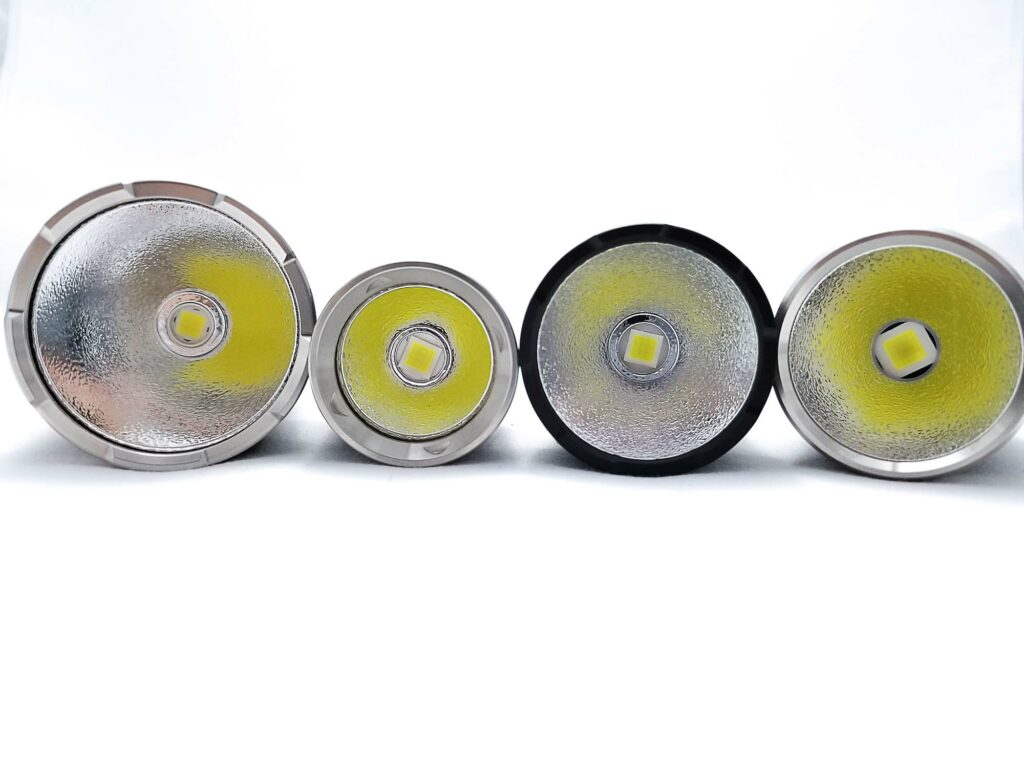
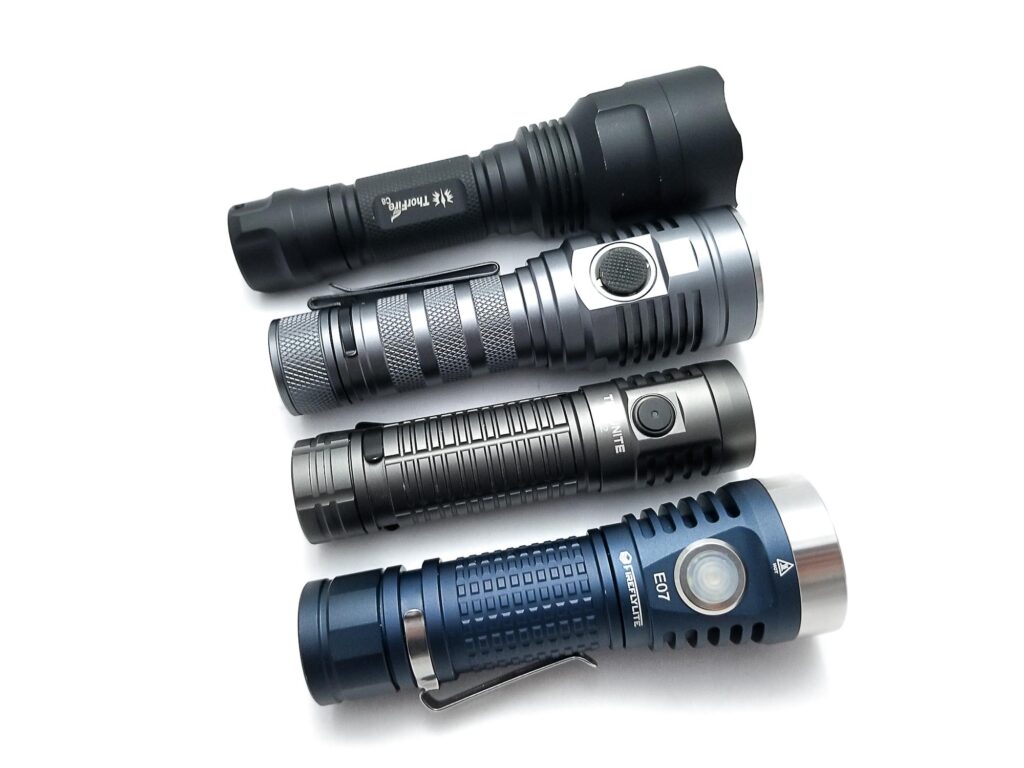
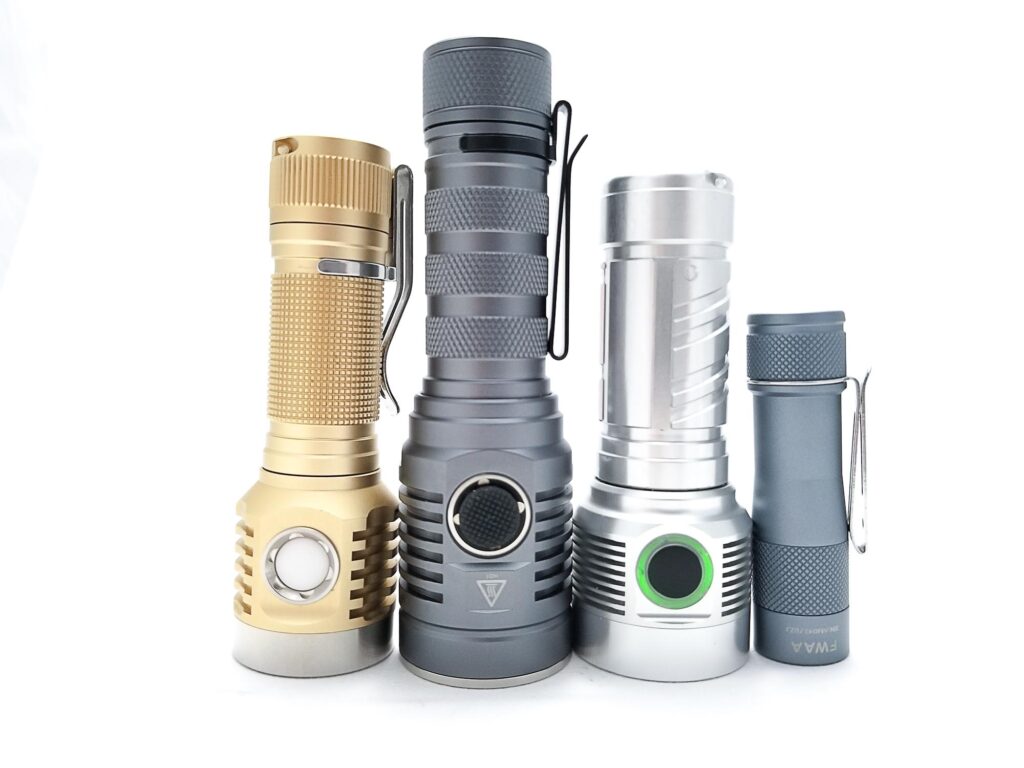
Driver & User Interface:
No mention is made of the driver, but I presume it’s going to be a linear FET driver. I removed the driver retaining ring and tried to pull it, but the LED wires are very short and I only got a little peak. It does have a 7135 chip on the bottom of the PCB, so it’s most likely a FET+1 driver.
The UI is typical of what I’m used to from Nightwatch. It’s a simple clicky/e-switch UI with 5 modes plus Turbo and Strobe. There’s one thing that spoils it though, and makes it a tough sell as an EDC-ready UI. More on that below.
Available modes: Moon, L1, L2, Medium, High, Turbo
Available blinky modes: Strobe
User interface:
From OFF:
- Press and Hold: Turns on in Moon
- Single click: Turns on in last mode
- 3 clicks: Strobe
- 4 clicks: Electronic lockout
- 2H (click, click hold): Momentary Turbo
From ON:
- Press and Hold: Turns off
- Single click: Switches modes
- 3 clicks: Strobe
- 4 clicks: Electronic lockout
- 2H (click, click hold): Momentary Turbo
Mode memory:
- Yes last mode memory
Shortcuts:
- To Turbo: 2H (click, click hold) activates momentary Turbo
- To Strobe: 3 clicks from on or off
- To Moon: Press and hold from off
Low voltage warning:
- The switch LED did turn red when the battery got low, but nothing was specified in the product description.
Strobe/blinkies
- Single Strobe accessed with a triple click from on or off
Lock-out mode:
- Lockout is activated from on or off with 4 consecutive clicks. If on, the light shuts off and will not turn on again under lockout. There’s no visual notifications the light is locked either. To disable, click 4 times again and the light turns on in the last mode.
PWM
- Yes, fast PWM in all modes, but not visible to the naked eye
Additional info on the UI:
- I’m somewhat disappointed in this UI. I liked the UI on the Nightwatch NI03 and NS59v1. They were simple, easy to negotiate, intuitive UIs, but the NG01’s UI is definitely not legendary. I’m not a fan of the 2H for Turbo, and I’m even less impressed that it’s momentary only, meaning it requires holding down the button to keep it running. I also don’t like the fact that the lockout feature doesn’t tell you if the light is locked. Nothing, nada. It’s also a little too easy to activate the lockout if you get a bit zealous with the clicks. I’m not a fan of press and hold for off on any UI, but for some reason on the NG01 it’s even less welcome. I digress though, since it’s easier to use than Anduril or Narsil, and doesn’t require configuring. The product page says there’s intelligent thermal control present, set to thermoregulate at 52 C. We shall see.
Batteries & Charging
The NG01 takes a 21700 battery, and you’re kind of limited in that respect since it really needs an unprotected, flat top high drain (30+A) 21700. A button top Samsung 50G worked, but it was an uncomfortably tight fit, and although using a weaker cell won’t hurt the light, it will hurt the performance quite a lot depending on the cell.
I recommend using a Samsung 40T, or Molicel P42A for the best balance of output and runtime, but the full output won’t be available unless you use a Samsung 30T or equivalent. The NG01 adds onboard charging this go-around, a first for a small light from Nightwatch that I can recall. It’s USB type C, and no charge current specs are listed, but I plugged it into the Haikelite HT90 with a USB type C to type C cable and it started charging at 5 volts 3 amps on my USB type C tester. I plugged it into a QC USB type A power bank with my Ruideng AT35 USB tester, and it started charging at 4.98 volts and about 2.9 amps. This is very fast charging, some of the fastest single-cell charging I’ve ever seen (besides the Lumintop D3), and a 21700 like the Molicel P42A would be charged in about 1.5 hours. Very impressive! The cell charged to 4.19 volts.
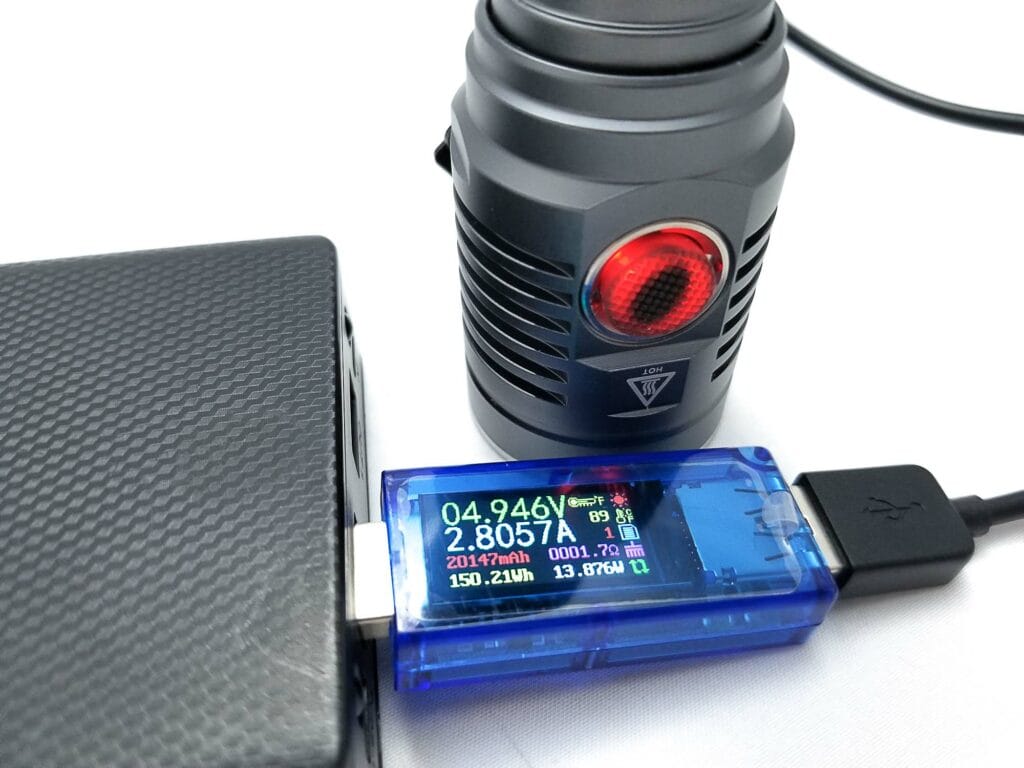
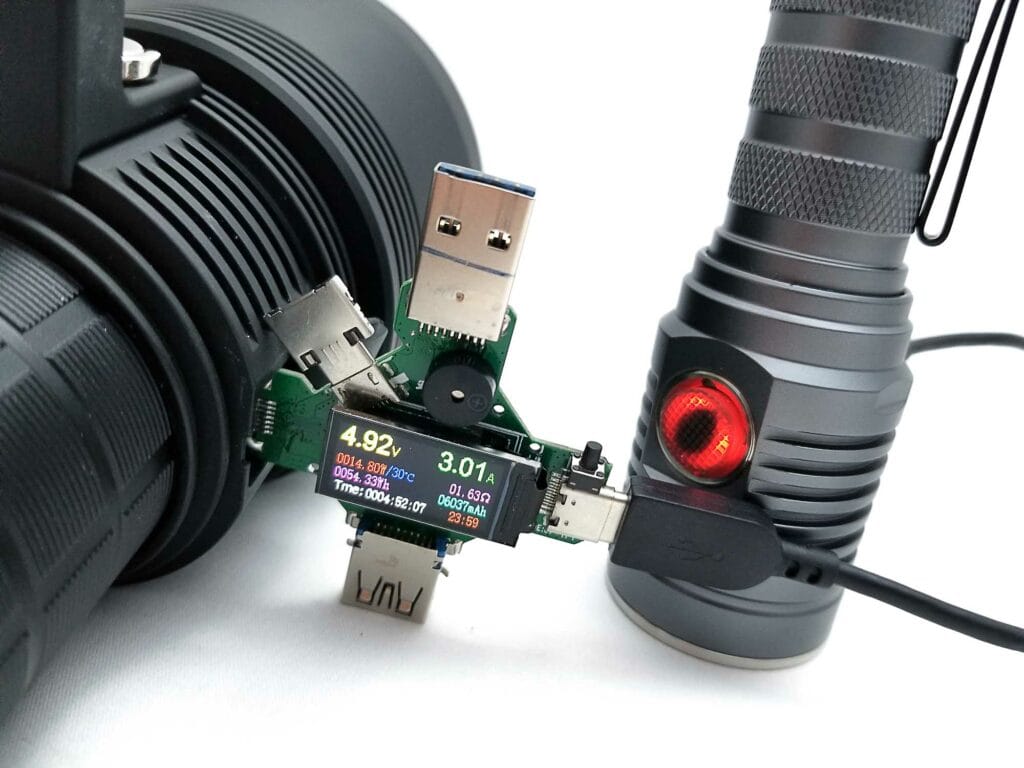
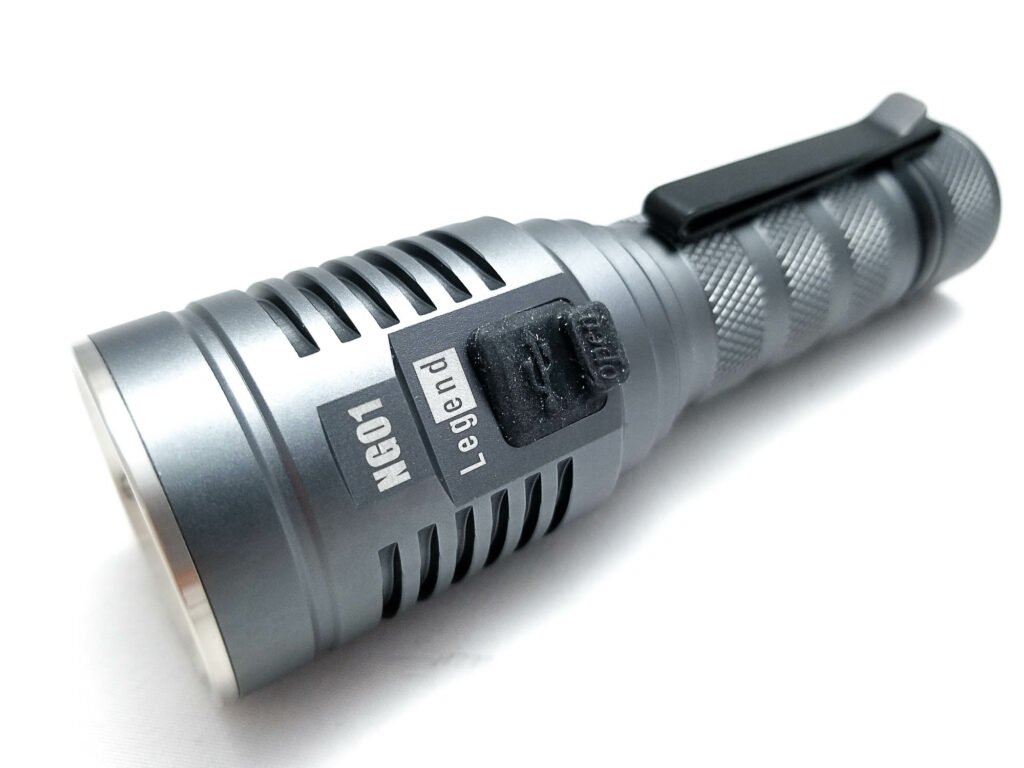
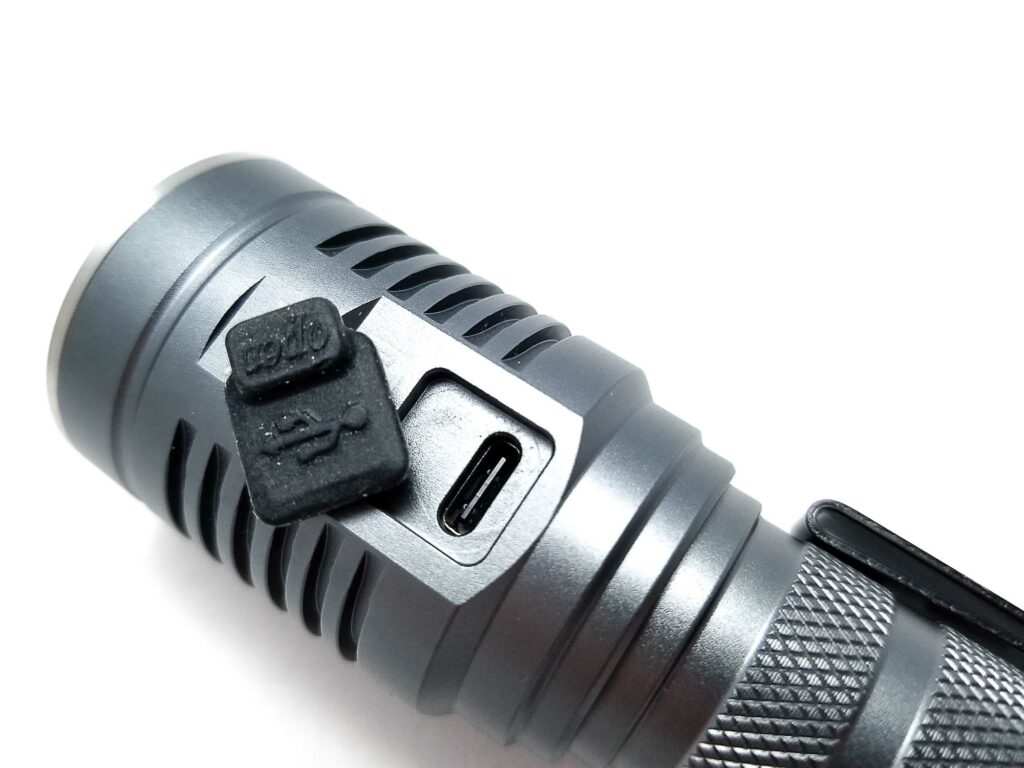
Performance test
Lumen measurements
Lumens are measured using my home made 50 cm integrating sphere, and I use a Digi-Sense 20250-00 datalogging luxmeter. The sphere has been calibrated using many lights of known output and is accurate within 10% of actual output. All measurements taken at 30 seconds. Amps were measured on a Samsung 30T with my Thsinde 18B+ multimeter with 14 gauge wires in the meter and higher currents with my FY219 clamp meter and a loop of 12 gauge wire.
| Mode | Amps at start | Specs | turn on | 30 sec | 10 minutes |
|---|---|---|---|---|---|
| Moon | 6.6 mA | ? | 1.25 lm | 1.25 lm | – |
| L1 | 230 mA | ? | 106 lm | 106 lm | – |
| L2 | 1.53 A | ? | 563 lm | 563 lm | – |
| Medium | 3.6 A | ? | 1143 lm | 1168 lm | 1054 lm |
| High | 5.78 A | ? | 1803 lm | 1791 lm | 89 lm |
| Turbo | 30 A | 7500 | 5588 lm | 5334 lm | 140 lm |
Parasitic drain:
- 0.3 mA
The numbers don’t lie, and I’m way down from the 7500 advertised Lumens for Turbo. The other numbers at turn on look good and are similar to an FW3A or KR4. It does hold Turbo a bit longer though. The issue is that the lights starts thermo regulating at about 60 seconds and the output starts throttling. At 10 minutes for High and Turbo, the differentials are dramatic, and at the lowest output High is under 100 Lumens and Turbo is under 140. No way around it folks: it’s bad.
Battery Life: Runtime graphs
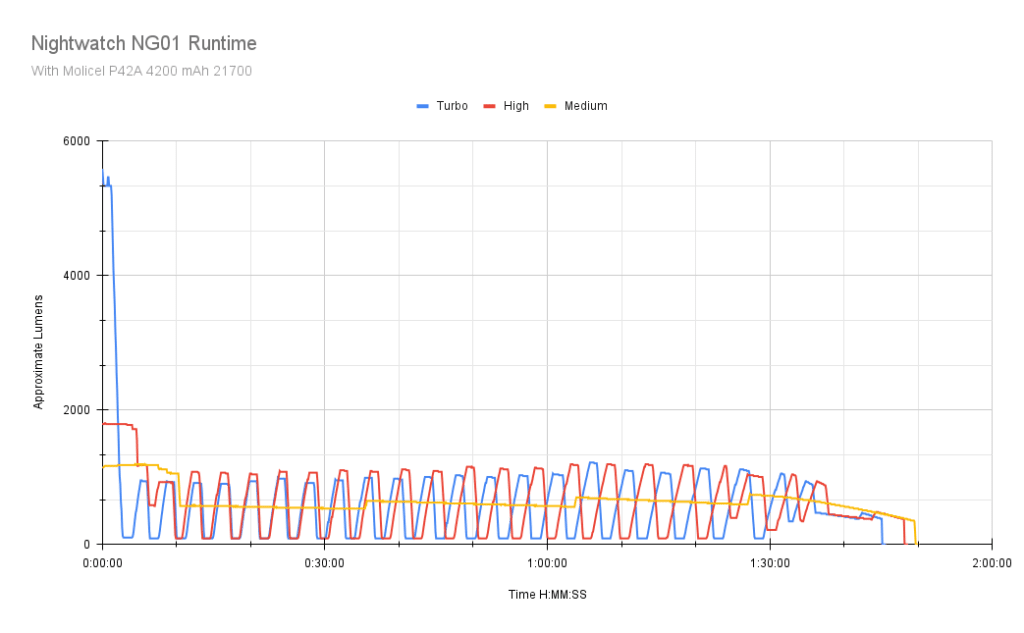
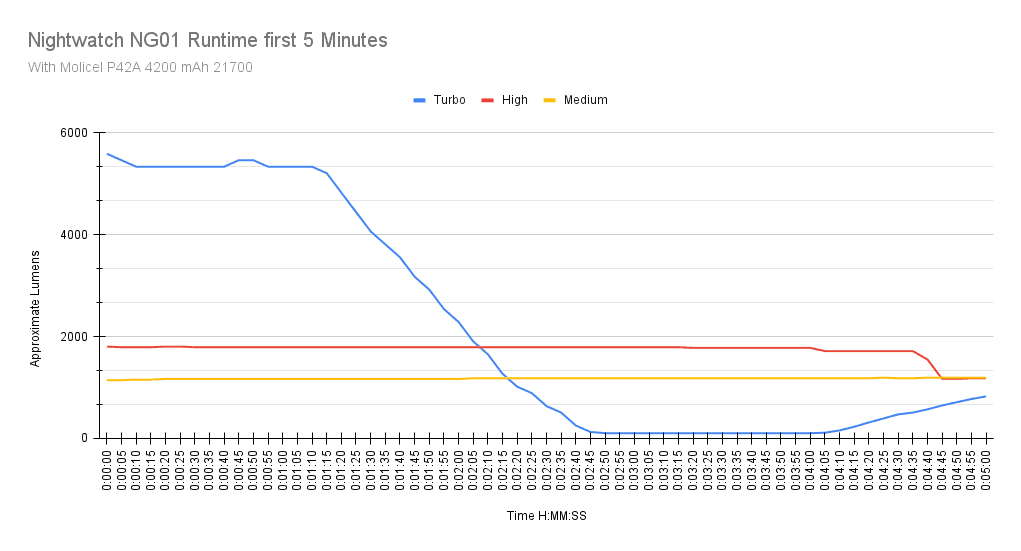
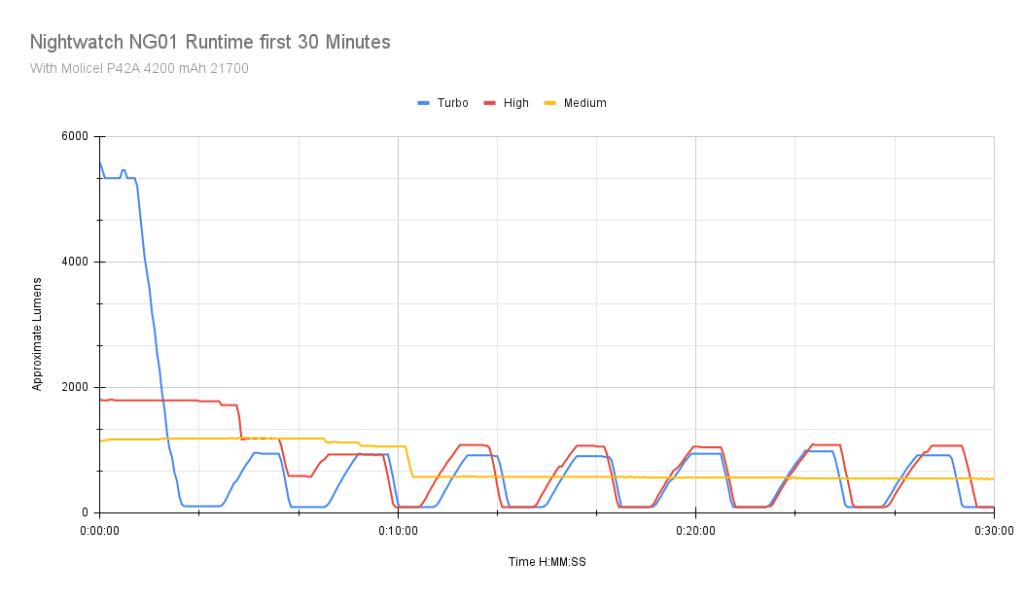
Runtimes are measured using my home made 50 cm integrating sphere, and I use a Digi-Sense 20250-00 datalogging luxmeter. I used a fully charged Molicel P42A 4200 mAh 21700 for each test. I tested Medium, High, and Turbo modes.
| Mode | Specified | Measured runtime (ANSI) | Time till shut off |
|---|---|---|---|
| Medium | ? | 1h 49min | 1h 49min |
| High | ? | 9min 50sec | 1h 48min |
| Turbo* | ? | 2min 35sec | 1h 45min |
Measuring the Turbo setting runtime was really challenging since it’s a momentary mode and requires holding the switch. I got creative and used a zip tie and a rubber block to keep constant pressure on the switch for hands-free action!
The runtime performance is, well…The graphs speak for themselves. The light is set to throttle at 52 C per the specs, but it’s closer to 55 C in my testing. Turbo stepped down at around 30 seconds, and heated up fast (from 25 ambient to 60 C in 25 seconds), and the highest temps I measured hit 71 C, and the light was too hot to handle after 2 minutes of High mode. Now I’m okay with thermal throttling in general, and I’ve seen some good ones and bad ones, but this has to be one of the poorer implementations, even worse than some of Sofirn/Wurkkos attempts. The changes in brightness are extremely noticeable and dramatic. No subtlety here. The brightness swings from 1000 Lumens to under 100 for High mode, and it’s not much better for Turbo. The ANSI runtimes for those modes are measured in minutes. Sad. I didn’t notice any visual LVP notifications, just the switch LEDs turning red.
ANSI FL1 standards: The runtime is measured until the light drops to 10% of its initial output (30 seconds after turning on). This does not mean that the flashlight is not usable anymore. The last column shows how long the light actually works till it shuts off. If there is a + symbol, it means that the test was stopped at that particular point, but the light was actually still running. This happens on certain occasions, with certain drivers, firmware, or batteries.
Peak beam intensity and beam distance measurements
Throw was measured indoors at 5 meters using the Uni-T UT383S luxmeter. I used a fully charged Molicel P42A battery. Measurements taken at 30 seconds.
| Mode | Specs | Candela measured | Meters | Yards |
|---|---|---|---|---|
| Moon | ? | N/A | – | – |
| L1 | ? | 625 cd | 50 | 54.6 |
| L2 | ? | 3675 cd | 121 | 132 |
| Medium | ? | 7175 cd | 169 | 185 |
| High | ? | 10,700 cd | 207 | 226 |
| Turbo | ? | 30,350 cd | 348 | 381 |
Moonlight was too dim at 5 meters for a reading. Nightwach doesn’t list a specific candela figure for the NG01, just a throw figure of 410 meters (probably on Turbo). I’m coming in under that at 30 seconds. At start up the figure jumps a bit to 366 meters. This is respectable distance for a large die LED light with a small reflector. If you need more distance, opt for the SFT-40-W version.
Extra info: Peak beam distance according to ANSI FL1 standards: The calculated value of distance in meters at which the flashlight produces a light intensity of 0.25 lux. (0.25 lux is about the brightness of a full moon shining on an object).
Beamshots
I compared the NG01 to some other high performance EDC lights. Photos taken with my Samsung Note 8. The 95 meter shots with the following camera settings 0.3s ISO 200 and 5000K WB.
Beamshots compared to the following flashlights (at 40 meters):
- Amutorch XT45 NB90.16
- Fireflies E07 2021
- WildTrail WT3M
- Nightwatch NI03 Valkyrie
- Lumintop D3
- Thrunite T2
- Emisar D1 2022
- Thorfire C8 (XHP50.2)
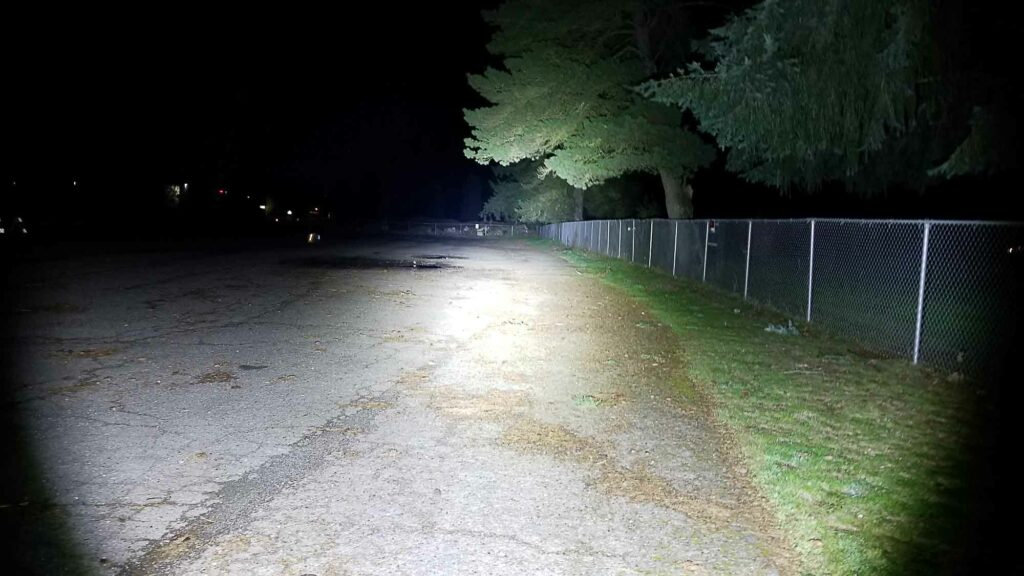




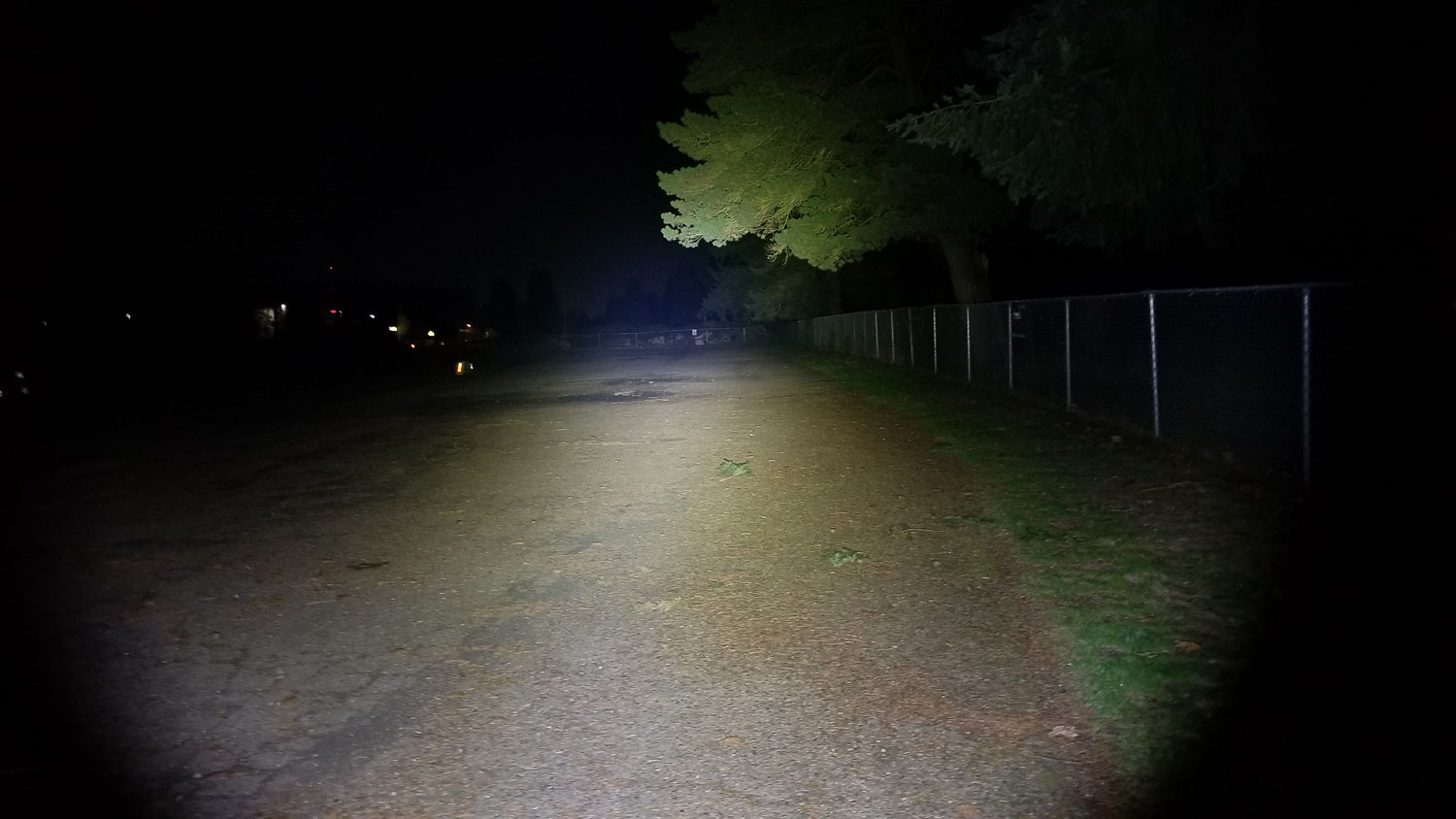
Disclaimer: This flashlight was sent to me for review at no cost by Nealsgadgets. I have not been paid to review, nor have I been holding back on problems or defects.
Final Verdict
Pros
- Compact and relatively lightweight
- Fast onboard charging
- Gets very bright
- Nice build quality, fit and finish
- Nice beam for EDC
- Simple UI
Cons
- Fast step down
- Poor thermal throttling/regulation
- 2H for Turbo
- No lanyard hole
- USB port cover dislodged easily
Explanation on star ratings:
1: Avoid: a match would be a better choice – 2: Poor: significant defect or issues; almost unusable – 3: Average: some defects or issues; but still usable 4: Good: recommended (minor issues) – 5: Great: highly recommended

2.5 stars: ★★⋆
At last, an EDC from our favorite high output flashlight brand. However, I can’t help but feel a bit disillusioned with the Nightwatch NG01. It checks some of the requisite boxes for an EDC piece: compact, relatively lightweight, pocketable, and high output. In addition, the NG01 embodies the things I like about Nightwatch lights as well, with a utilitarian design, solid construction and nice build quality. It doesn’t skimp on the niceties that are missing from some of the most popular EDC lights around either, with properly fast USB type C charging and a simple UI.
The output is very good as well. It’s brighter than just about every single cell EDC light out there, besting the FW3A, FW4, KR4, and KR1 with SBT90.2. It’s even brighter than some larger lights as well, like the Thrunite TC20 V2 and Thrunite T2 (without the double-ugly Cree beams and tint). However, the positives pretty much stop there though. I expected a fast step down, but the really bad thermal regulation, wonky USB port cover, and the lack of any lanyard mounting points really soured the whole deal. 2H for Turbo isn’t a huge deal, but I’d rather have 2C for that.
While this is a respectable first effort from Nightwatch (at least for buyers outside China), there’s room for improvement. Keep the high output, nice beam quality, and solid host, tweak the firmware and thermal throttling (or just give it Anduril 2), and Nightwatch would have a great (maybe legendary?) EDC flashlight on their hands. For now though, and with so many other better-performing and more refined options out there, it’s hard for me to recommend the NG01 as-is. 2.5 stars for the NG01.
Nightwatch NG01 for sale
Coupon code at Nealsgadgets: 1LumenNew & 1Lumen711 (15-25% off)
1lumen selects and reviews products personally. We may earn affiliate commissions through our links, which help support our testing.